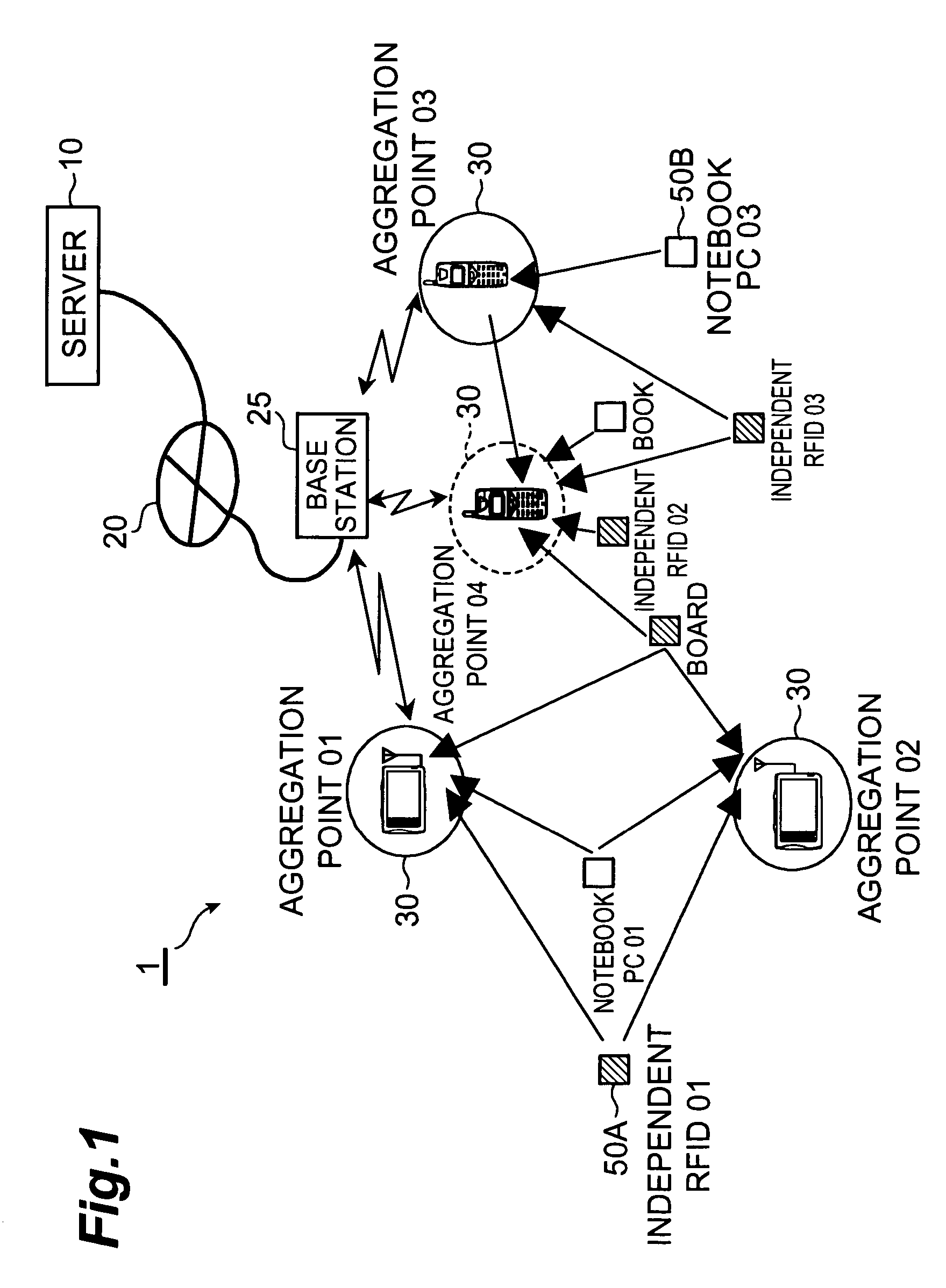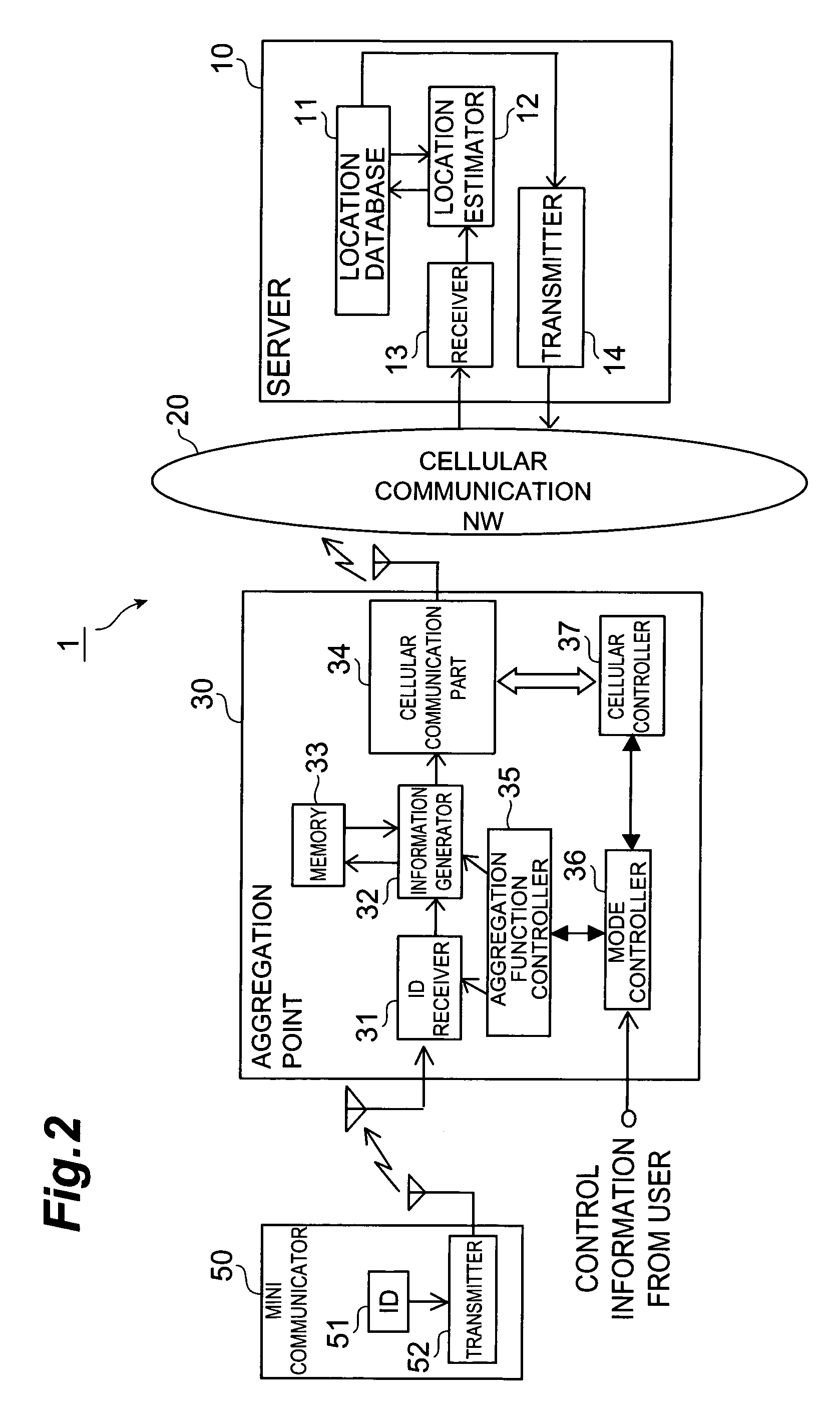Mobile communication terminal, server, communication system, communication control method, and communication control program
a mobile communication terminal and server technology, applied in the field of mobile communication terminals, can solve the problems of increasing the traffic in cellular communication networks, consuming a huge amount of power for reception transactions at intervals of predetermined time, and affecting the efficiency of mobile communication, so as to reduce the transmission processing load, reduce the network traffic, and smooth the communication traffic
- Summary
- Abstract
- Description
- Claims
- Application Information
AI Technical Summary
Benefits of technology
Problems solved by technology
Method used
Image
Examples
first embodiment
Various Modifications about First Embodiment
[0110]The component for estimating the location of RFID 50 does not have to be limited to server 10, but may be the aggregation point 30. Namely, the aggregation point 30 is arranged to further receive from another aggregation point, other terminal information containing an ID of an RFID, the reception intensity of the radio wave from the RFID, and the location information of the other aggregation point, whereby the aggregation point 30 can estimate the location of the RFID in similar fashion to above, based on the reception intensity of the radio wave from the RFID measured by itself and on the other terminal information thus received. In this case, the processing load increases on each aggregation point, while there is the advantage that the traffic can be reduced in the cellular communication network. Specifically, as shown in FIG. 28, the aggregation point 30X is preferably configured to further comprise location database 44B memorizin...
second embodiment
[0113]The second embodiment will illustrate a configuration of RFID 50 for preventing interference.
[0114]There are cases in which a plurality of RFIDs 50 simultaneously transmit their radio waves to one aggregation point 30. For this reason, it is necessary to adopt some means for preventing interference among the radio waves from the RFIDs 50 at aggregation point 30. A solution is a method of preliminarily determining transmission intervals of radio waves from RFIDs 50 individually for the respective RFIDs and letting each RFID 50 transmit the radio wave at the transmission intervals determined. In use of this method, even if radio waves from different RFIDs 50 temporally overlap each other at a certain timing to cause interference, the radio waves will not temporally overlap each other at the next transmission timing, so as to prevent interference.
[0115]Other methods include a method of randomly changing the transmission intervals of radio wave from the same RFID 50 by itself, a m...
third embodiment
[0116]Next, the third embodiment will illustrate an embodiment in which the aggregation point 30 authenticates whether an RFID 50 as a transmitter of a radio wave is a qualified one. In the present embodiment, specific configurations are provided in RFID (mini-communicator) 50 as shown in FIG. 11 and in ID receiving part 31 in aggregation point 30 as shown in FIG. 12.
[0117]As shown in FIG. 11, RFID 50 is comprised of time stamp generating part 54 which generates a time stamp indicating a transmission time of ID information; signature generating part 55 which generates an electronic signature; private key storage part 56 which stores a private key; ID memory part 51 comprised of a ROM or the like memorizing the ID information of the RFID; multiplexing part 57 which multiplexes the ID information, time stamp, and electronic signature; and transmission part 52 which transmits the multiplexed information through a radio link.
[0118]As shown in FIG. 12, ID receiving part 31 is comprised o...
PUM
 Login to View More
Login to View More Abstract
Description
Claims
Application Information
 Login to View More
Login to View More - R&D
- Intellectual Property
- Life Sciences
- Materials
- Tech Scout
- Unparalleled Data Quality
- Higher Quality Content
- 60% Fewer Hallucinations
Browse by: Latest US Patents, China's latest patents, Technical Efficacy Thesaurus, Application Domain, Technology Topic, Popular Technical Reports.
© 2025 PatSnap. All rights reserved.Legal|Privacy policy|Modern Slavery Act Transparency Statement|Sitemap|About US| Contact US: help@patsnap.com



